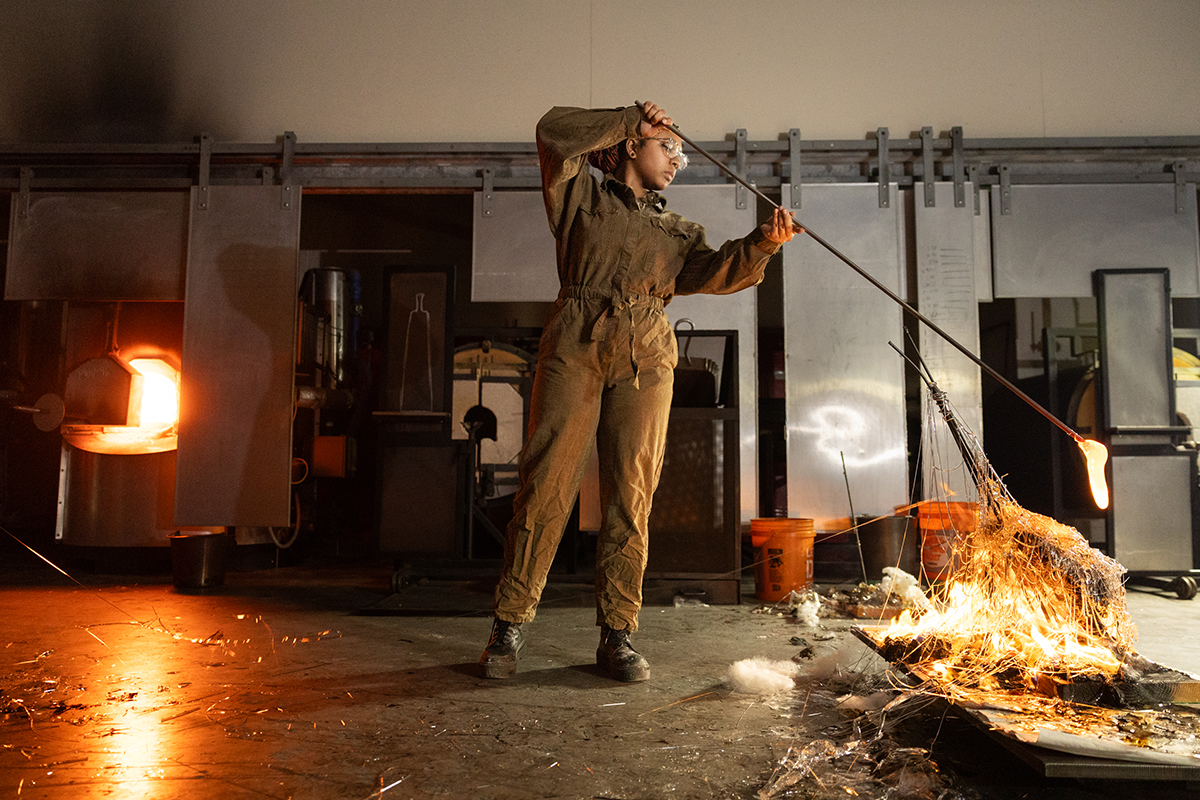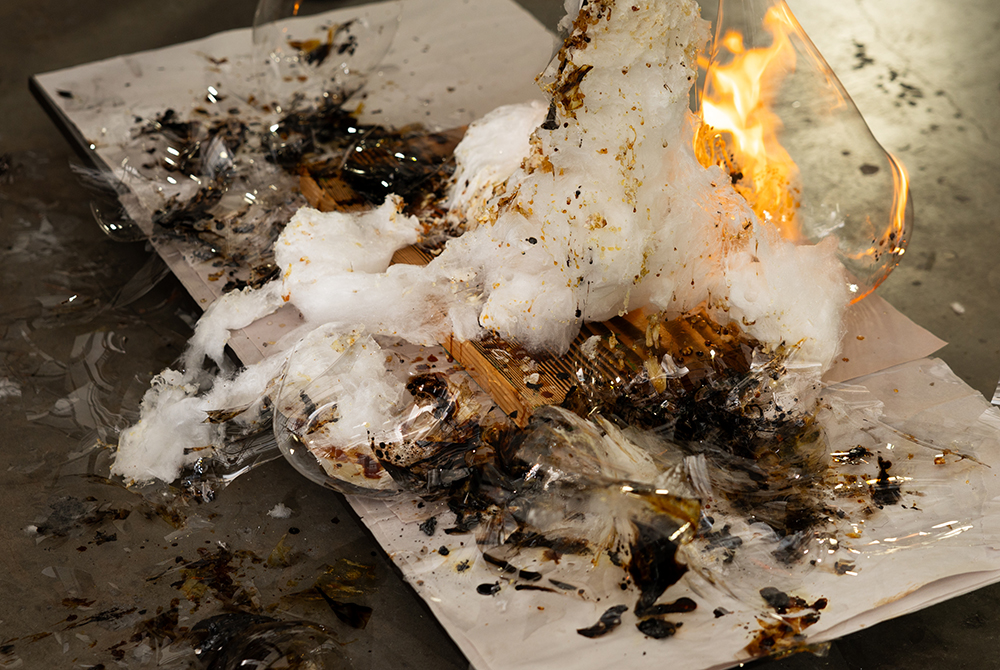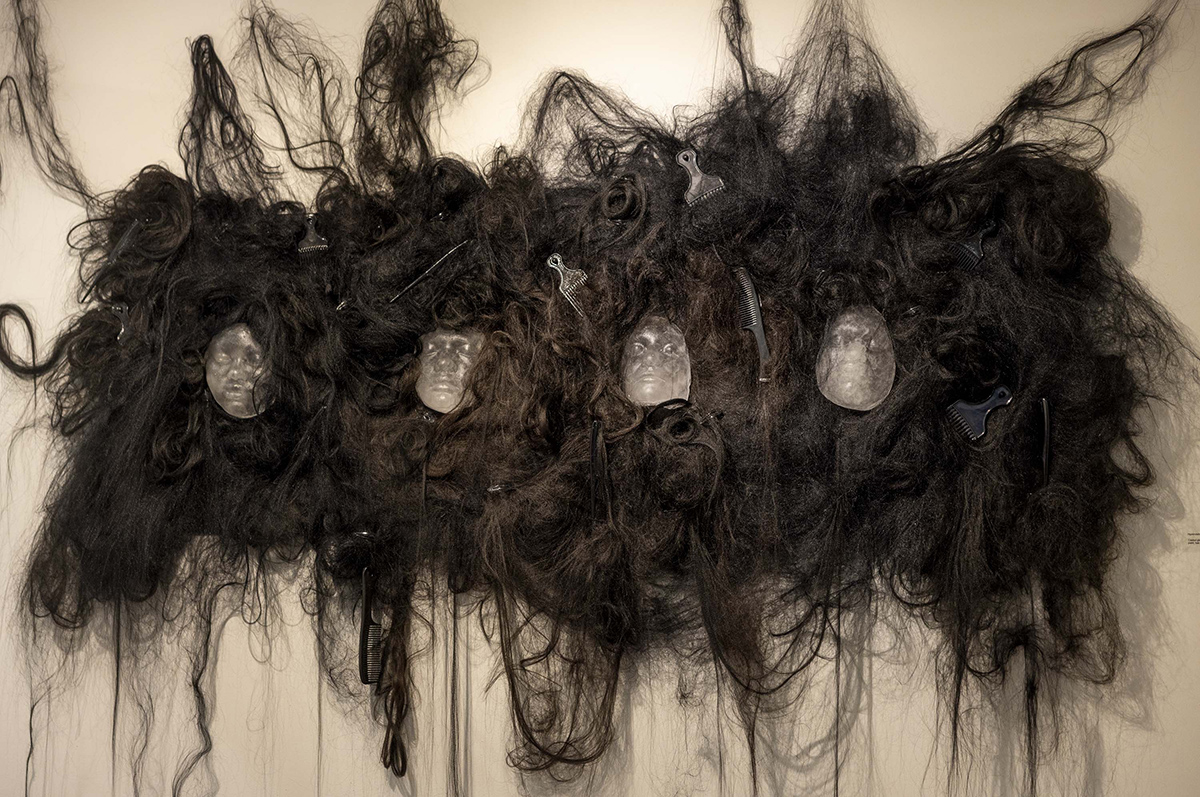Recent glass graduate continues RIT trend of Windgate-Lamar Fellowship recipients
Quinn Freidenburg '24
Spider Martins leads a Gaffer Night, a series that allows RIT glass students to express creativity through a glassblowing performance in the hot shop.
Flames melt away molds of busts made from many pounds of chocolate, brown sugar, and hardened sugar as Spider Martins ’24 (studio arts BFA - glass option) leads a thoughtful art performance in RIT’s hot shop.
As the consumables melted, so did the stereotypes Martin aims to break down in their work.
“It signified destroying these stereotypes that have been built up around the Black, feminine body,” Martins said. “Oftentimes it’s compared to things like sugar, chocolate, caramel. It has a long, negative history of the Black female body, just being seen as something that is consumable.”
Quinn Freidenburg '24
One of the molds Martins made for their Gaffer Night performance melts away.
The demo was part of the RIT glass program’s Gaffer Night series, which allows glass students to express creativity through a glassblowing performance in the hot shop. For Martins, a trained dancer, gaffer nights have been a welcome addition to their artistic world.
“Performance can be so much more (than traditional forms like singing and dancing),” Martins said. “Gaffer nights really opened that up for me and allowed me to incorporate it into my glass practice and sculptural practice.”
Martins is a recipient of this year’s Windgate-Lamar Fellowship, which, through the Center for Craft, annually offers $15,000 to 10 graduating undergraduate college students with exemplary skill in craft. The fellowship is among the most notable honors for emerging craft artists. Martins is the fourth RIT recipient in the last six years (Eric Meeker - glass 2018, Ethan Townsend - glass 2020, and Mikey Gambino - ceramics 2023).
Martins’ Windgate-Lamar proposal was an extension of their studio work that challenges the notion of what constitutes “high craft.”
“A lot of times, high craft has been attributed to more Euro-centric forms of making — if something is high-quality glass, if it’s super-clear glass, super thin, super delicate, it’s seen as more valuable,” Martins said. “And then methods of working with glass that originate from Africa, they’re often looked down upon and seen as not as high quality or high craft. How do we determine what things are valuable versus not as valuable?”
Quinn Freidenburg '24
Artifacts from Martins' Gaffer Night performance.
Martins incorporates personal identity in their work to fracture high craft ideologies. Martins’ own hair, fingernails, and wisdom teeth have all found their way into pieces she created.
For another gaffer night, Martins made a giant glass reliquary that was subsequently stocked with hair she burned off using hot glass. Martins considers themself an artonist — “when art meets arson.”
For a separate installation, she melted and cracked glass vessels, mended by braided hair that permeated cracks in the vessels’ new forms. Martins has also worked braids into molds to produce glass braids when they’re filled.
“With incorporating African hair-braiding techniques into my work, throughout history, hair braiding hasn’t been seen as a high craft type of artform, which it is,” Martins said. “My work is about celebrating diversity and decentralizing Euro-centric art practices that are often praised — the notion that if it’s not euro-centric, that’s not really high craft or high quality.”
Martins entered RIT as a studio arts exploration student, using the opportunity to investigate different materials and decide the discipline she was best suited for. Before arriving at RIT, she took metalsmithing and ceramics classes and workshops, and was exposed to furniture making through their father.
But once she worked with glass for the first time their freshman year, Martins was hooked.
“A big part of it was the community,” Martins said of becoming a glass student. “Everyone in glass was super cool and nice all the time. Whenever I had an idea I wanted to try, everyone was on board.”
Caitlyn Daproza '26
Martins' "Hypervisible" installation that is part of their senior capstone exhibition in Bevier Gallery. With their capstone body of work, "The Object Body," Martins explained, "Using my likeness and the likeness of other Black Femmes, I reimagine our likeness into clear cast glass transforming our identities from subjects of objectification into tangible symbols of resilience and strength."
Working in the hot shop alongside experienced faculty, graduate students and older undergraduate students, Martins said, held them to a high standard as she was learning the discipline. Picking the brains of peers, coupled with strong personal drive, proved critical in Martins’ development as a glass artist.
“The material itself, there is so much potential for possibilities of what you can do with it,” Martins said. “It’s so diverse, the different methods of making and things you can make with glass. I just was like, ‘I have to figure out how to work with this material and get better at it.’ I just love glass.”
Martins is keeping busy after graduating.
She received a pair of fellowships to study and work at Pilchuck Glass School (Stanwood, Wash.) and Haystack Mountain School of Crafts (Deer Isle, Maine) this summer.
Those experiences will be followed by internships at UrbanGlass (Brooklyn, N.Y.) and GlassRoots (Newark, N.J.), where she will assist in teaching workshops and use studio facilities to expand their practice.















